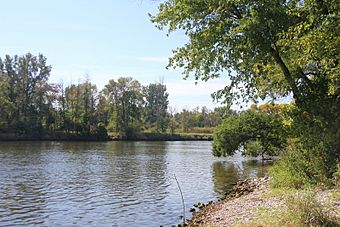Battle Point Site facts for kids
Quick facts for kids |
|
|
Battle Point Site
|
|
 |
|
| Location | Battle Point, Grand River |
|---|---|
| Area | 2 acres (0.81 ha) |
| NRHP reference No. | 73000956 |
| Added to NRHP | August 14, 1973 |
The Battle Point Site is an important place where archaeologists study the past. It's also known as 20OT50. This site is located on Battle Point, right next to the Grand River in Crockery Township, Ottawa County, Michigan. Because of its historical value, it was added to the National Register of Historic Places in 1973.
A Look Back in Time: The History of Battle Point
Battle Point was once home to a village and a burial ground for the Odawa Native American people. They likely used this area for about 20 years, between 1815 and 1835. A leader named Chief Onamontapay guided the Odawa who lived here.
In 1836, a very important agreement called the Treaty of Washington was signed. This treaty meant that the lands north of the Grand River became part of the United States. After this, a Potawatomi leader named Chief Shiawassee, who lived nearby, called a meeting at Battle Point. He tried to convince the Odawa and other local groups to resist the new changes. However, a person named Rev. William Ferry and his Native American friends helped to calm the situation.
Soon after, Chief Shiawassee and his Potawatomi people moved away from the area. Around the same time, the Odawa village at Battle Point was left empty. But some Odawa families chose to stay in the area. In 1855, a school for Native American children was even started on Battle Point. These families continued to live around Battle Point until at least 1878.
Uncovering the Past: Archaeological Discoveries
For many years, the burial sites at Battle Point were forgotten. But in the 1950s, amateur archaeologists learned about the site. This happened because the river's strong currents caused erosion, which uncovered some of the old burial places.
Five of these burial sites were carefully dug up by a group called the Coffinberry chapter of the Michigan Archaeological Society. Later, in 1971 and 1972, researchers from Grand Valley State University excavated nine more graves.
The items found in these burial sites were mostly trade goods from America and Europe. Some were useful tools, like knives, tools for starting fires, gunflints, axes, and cooking pots. Other items were decorative, such as silver brooches and bracelets, clay pipes, and colorful glass beads. These finds help us understand how the Odawa people lived and traded with others during that time.



